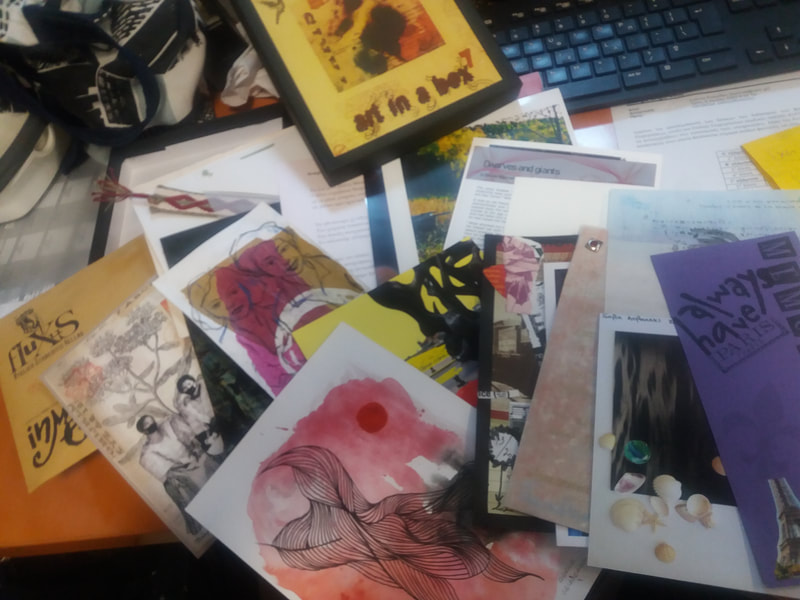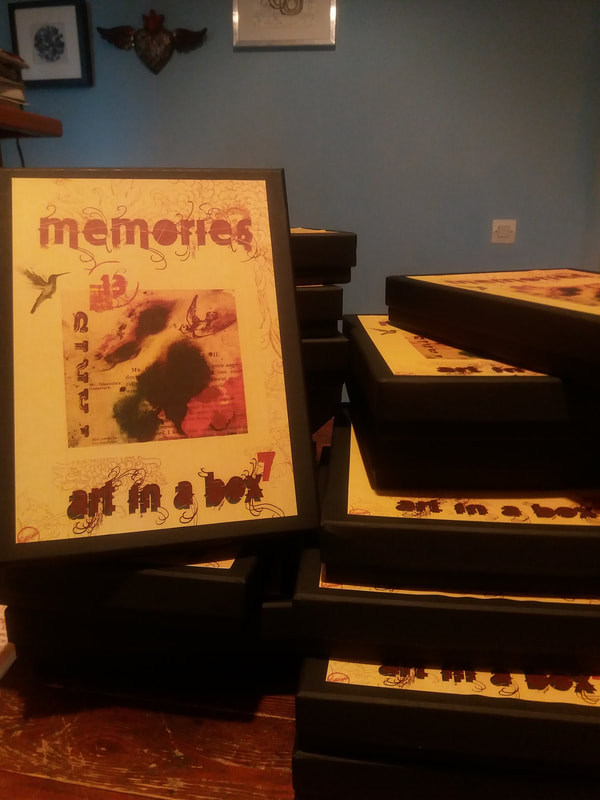“Memory is the only lasting possession we have. I have made my life the subject of my work, using the images of home, the places I have visited, and the stars I have looked up to. I just want a reminder that I did not imagine my experiences.”
Zarina (1937-April 25, 2020) R.I.P.
Zarina (1937-April 25, 2020) R.I.P.
|
Το Art in a Box είναι ένα κουτί ανταλλαγής στο οποίο συμμετέχουν 20 δημιουργοί.
Κάθε συμμετέχοντας θα πρέπει να στείλει 20 έργα σε χαρτί, αριθμημένα και υπογεγραμμένα, διαστάσεων μέχρι 15χ21. Τηρείται σειρά προτεραιότητας και το κουτί κλείνει μόλις συμπληρωθούν οι 20 συμμετοχές. Σε περίπτωση που συμπληρωθεί ο αριθμός αυτός, οι συμμετοχές που μένουν εκτός, πάνε στο επόμενο κουτί. Κάθε κουτί είναι αριθμημένο και ο κάθε συμμετέχοντας λαμβάνει απο ένα συλλεκτικό κουτί, με 20 διαφορετικά έργα. Το κόστος συμμετοχής είναι 10€ και καλύπτει το κόστος του κουτιού και τα ταχυδρομικά τέλη αποστολής του. Δεκτές γίνονται όλες οι τεχνικές σε χαρτί (εκτός απο φωτοτυπίες), φωτογραφίες, κολάζ, χαρακτικά, mail art, χειροποίητα βιβλιαράκια, μικρές ιστορίες, ποιήματα, διηγήματα ή οτιδήποτε άλλο χωράει σε ένα κουτί! |
Art in a Box is an exchange art box with 20 participant artists.
Each participant has to send 20 artworks, numbered and signed. The size can be up to 15x21cm. A priority order is kept and the box closes when the 20 entries have received. If the box is closed, the artworks that are left out, go to the next box. Each box is numbered and each participant receives a box with 20 different artworks. The participation fee is € 10 and covers the cost of the box and the shipping postage. We accept all the techniques on paper (except photocopies), photographs, collages, engravings, mail art, handmade booklets, short stories, poems, short stories or anything that fits in a box! |
|
Θέμα: Αναμνήσεις
Προσπαθήστε να σκεφτείτε τι φάγατε το μεσημέρι πριν από τρεις εβδομάδες. Πιθανότατα δεν περνάει τίποτα από το μυαλό σας. Εάν πάλι προσπαθήσετε να θυμηθείτε τα προηγούμενα γενέθλιά σας, μάλλον κάτι θα σας έχει μείνει από εκείνη την ημέρα. Γιατί, όμως, μπορούμε και θυμόμαστε μερικά πράγματα, ενώ άλλα τα ξεχνάμε εντελώς; Γιατί μερικές αναμνήσεις ξεφτίζουν;
Αρχικά, όλες μας οι εμπειρίες μετατρέπονται σε μικρά κομμάτια πληροφοριών που αρχικά πηγαίνουν στην βραχυπρόθεσμη μνήμη μας μέσα από τους νευρώνες του εγκεφάλου. Μέσα από μία διαδικασία και επεξεργασία των πληροφοριών αυτών, και συγκεκριμένα μέσα από το γεγονός ότι οι νευρώνες επικοινωνούν μεταξύ τους σταθερά, μερικές από τις αναμνήσεις ταξιδεύουν από την βραχυπρόθεσμη μνήμη στην μακροπρόθεσμη, όπου και αποθηκεύονται. Για το αν μία πληροφορία θα πάει εκεί, υπάρχουν πολλοί παράγοντες που διαδραματίζουν ρόλο. Για παράδειγμα, εάν είστε συγκεντρωμένοι και συνδεδεμένοι με την εμπειρία που λαμβάνει χώρα είναι πιο πιθανό να διατηρήσετε την ανάμνηση αυτή στο κεφάλι σας για περισσότερο καιρό. Υπάρχουν και άλλοι παράγοντες, όμως, που επηρεάζουν τη μνήμη και κάνουν τις αναμνήσεις να χάνονται. Η ηλικία είναι ένα χαρακτηριστικό παράδειγμα. Όσο μεγαλώνουμε οι νευρώνες του εγκεφάλου μας γίνονται λιγότερο ευαίσθητοι. Για την ακρίβεια, οι επιστήμονες έχουν διαπιστώσει ότι μειώνεται ο αριθμός των νευρώνων στον ιππόκαμπο. Επιπλέον, οι περισσότερες αναμνήσεις αποτυπώνονται ότι είμαστε συγκεντρωμένοι, αλλά συναισθηματικές διαταραχές, όπως η κατάθλιψη, δεν επιτρέπουν στο άτομο να συγκεντρωθεί σε νέες καταστάσεις, οπότε και να δημιουργήσει νέες αναμνήσεις. Αντίθετα, το άτομο σκέφτεται συνέχεια τα δυσάρεστα του παρελθόντος και επικεντρώνεται σε αυτά. Έχει διαπιστωθεί ότι όσοι πάσχουν από κατάθλιψη έχουν 40% λιγότερη δυνατότητα να διατηρήσουν αναμνήσεις. Η απομόνωση, που βιώνουν τα άτομα που πάσχουν από κατάθλιψη δεν επιτρέπει στον εγκέφαλό τους να «ασκηθεί» μέσα από την κοινωνική συναναστροφή. Ένας ακόμα «κλέφτης» της μνήμης είναι το χρόνιο άγχος. Κατά τη διάρκεια του έντονου άγχους το σώμα βρίσκεται σε επιφυλακή, προκειμένου να προστατευτεί από τον «κίνδυνο». Αυτή η διαδικασία, όμως, με τα χρόνια μειώνει τη λειτουργία του εγκεφάλου και οδηγεί σε θάνατο πολλά από τα εγκεφαλικά κύτταρα του ανθρώπου. |
The theme of the Art in a Box is:
memories Memory is the faculty of the brain by which data or information is encoded, stored, and retrieved when needed. It is the retention of information over time for the purpose of influencing future action.[1] If past events could not be remembered, it would be impossible for language, relationships, or personal identity to develop.[2] Memory loss is usually described as forgetfulness or amnesia.[3][4][5][6][7][8] Memory is often understood as an informational processing system with explicit and implicit functioning that is made up of a sensory processor, short-term (or working) memory, and long-term memory.[9] This can be related to the neuron. The sensory processor allows information from the outside world to be sensed in the form of chemical and physical stimuli and attended to various levels of focus and intent. Working memory serves as an encoding and retrieval processor. Information in the form of stimuli is encoded in accordance with explicit or implicit functions by the working memory processor. The working memory also retrieves information from previously stored material. Finally, the function of long-term memory is to store data through various categorical models or systems.[9] Declarative, or explicit, memory is the conscious storage and recollection of data.[10] Under declarative memory resides semantic and episodic memory. Semantic memory refers to memory that is encoded with specific meaning,[2] while episodic memory refers to information that is encoded along a spatial and temporal plane.[11][12][13] Declarative memory is usually the primary process thought of when referencing memory.[2] Non-declarative, or implicit, memory is the unconscious storage and recollection of information.[14] An example of a non-declarative process would be the unconscious learning or retrieval of information by way of procedural memory, or a priming phenomenon.[2][14][15] Priming is the process of subliminally arousing specific responses from memory and shows that not all memory is consciously activated,[15] whereas procedural memory is the slow and gradual learning of skills that often occurs without conscious attention to learning.[2][14] Memory is not a perfect processor, and is affected by many factors. The ways by which information is encoded, stored, and retrieved can all be corrupted. The amount of attention given new stimuli can diminish the amount of information that becomes encoded for storage.[2] Also, the storage process can become corrupted by physical damage to areas of the brain that are associated with memory storage, such as the hippocampus.[16][17] Finally, the retrieval of information from long-term memory can be disrupted because of decay within long-term memory.[2] Normal functioning, decay over time, and brain damage all affect the accuracy and capacity of the memory.[18][19] source:https://en.wikipedia.org/wiki/Memory |



